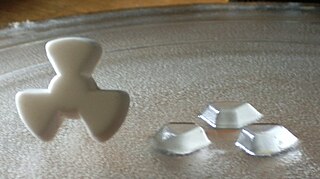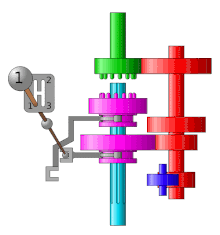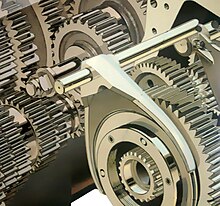
A clutch is a mechanical device that allows the output shaft to be disconnected from the rotating input shaft. The clutch's input shaft is typically attached to a motor, while the clutch's output shaft is connected to the mechanism that does the work.
Double-clutching is a method of shifting gears used primarily for vehicles with an unsynchronized manual transmission, such as commercial trucks and specialty vehicles. While double clutching is not necessary in a vehicle that has a synchronized manual transmission, the technique can be advantageous for smoothly downshifting in order to accelerate and, when done correctly, it prevents wear on the synchronizers which normally equalize transmission input and output speeds to allow downshifting.

An automatic transmission is a multi-speed transmission used in motor vehicles that does not require any input from the driver to change forward gears under normal driving conditions. Vehicles with internal combustion engines, unlike electric vehicles, require the engine to operate in a narrow range of rates of rotation, requiring a gearbox, operated manually or automatically, to drive the wheels over a wide range of speeds.

A transmission is a mechanical device which uses gears to change the speed or direction of rotation in a machine. Many transmissions have multiple gear ratios, but there are also transmissions that use a single fixed gear ratio.

A manual transmission (MT), also known as manual gearbox, standard transmission, or stick shift, is a multi-speed motor vehicle transmission system, where gear changes require the driver to manually select the gears by operating a gear stick and clutch.

In mechanical or automotive engineering, a freewheel or overrunning clutch is a device in a transmission that disengages the driveshaft from the driven shaft when the driven shaft rotates faster than the driveshaft. An overdrive is sometimes mistakenly called a freewheel, but is otherwise unrelated.
A semi-automatic transmission is a multiple-speed transmission where part of its operation is automated, but the driver's input is still required to launch the vehicle from a standstill and to manually change gears. Semi-automatic transmissions were almost exclusively used in motorcycles and are based on conventional manual transmissions or sequential manual transmissions, but use an automatic clutch system. But some semi-automatic transmissions have also been based on standard hydraulic automatic transmissions with torque converters and planetary gearsets.

A drive shaft, driveshaft, driving shaft, tailshaft, propeller shaft, or Cardan shaft is a component for transmitting mechanical power, torque, and rotation, usually used to connect other components of a drivetrain that cannot be connected directly because of distance or the need to allow for relative movement between them.

Hydramatic is an automatic transmission developed by both General Motors' Cadillac and Oldsmobile divisions. Introduced in 1939 for the 1940 model year vehicles, the Hydramatic was the first mass-produced fully-automatic transmission developed for passenger automobile use.

A direct-shift gearbox is an electronically controlled, dual-clutch, multiple-shaft, automatic gearbox, in either a transaxle or traditional transmission layout, with automated clutch operation, and with fully-automatic or semi-manual gear selection. The first dual-clutch transmissions were derived from Porsche in-house development for the Porsche 962 in the 1980s.

A preselector gearbox is a type of manual transmission mostly used on passenger cars and racing cars in the 1930s, in buses from 1940-1960 and in armoured vehicles from the 1930s to the 1970s. The defining characteristic of a preselector gearbox is that the gear shift lever allowed the driver to "pre-select" the next gear, usually with the transmission remaining in the current gear until the driver pressed the "gear change pedal" at the desired time.

The automated manual transmission (AMT) is a type of transmission for motor vehicles. It is essentially a conventional manual transmission equipped with automatic actuation to operate the clutch and/or shift gears.

A sequential manual transmission, also known as a sequential gearbox, or a sequential transmission, is a type of non-synchronous manual transmission used mostly for motorcycles and racing cars. It produces faster shift times than traditional synchronized manual transmissions, and restricts the driver to selecting either the next or previous gear, in a successive order.

The Tremec TR-6060 six-speed manual transmission features six forward speeds and one reverse speed. It is derived from the Tremec T-56 6-speed manual transmission. As usual, the forward helical cut gears are synchronized. However, the reverse gear operates through a fully synchronized constant-mesh system. The TR-6060 contains removable wear pads on the shift forks, and uses aluminum alloys for the main case, extension housing, and clutch housing. It is a double overdrive transmission. The TR-6060 is manufactured by TREMEC and is rated for 430 lb⋅ft (580 N⋅m) to 650 lb⋅ft (880 N⋅m) of torque, depending on gearing.

A dog clutch is a type of clutch that couples two rotating shafts or other rotating components by engagement of interlocking teeth or dogs rather than by friction. The two parts of the clutch are designed such that one will push the other, causing both to rotate at the same speed and will never slip. In engineering, a "dog" is a tool or device used to lock two components in relation to each other.

A dual-clutch transmission (DCT) is a type of multi-speed vehicle transmission system, that uses two separate clutches for odd and even gear sets. The design is often similar to two separate manual transmissions with their respective clutches contained within one housing, and working as one unit. In car and truck applications, the DCT functions as an automatic transmission, requiring no driver input to change gears.

A motorcycle transmission is a transmission created specifically for motorcycle applications. They may also be found in use on other light vehicles such as motor tricycles and quadbikes, go-karts, offroad buggies, auto rickshaws, mowers, and other utility vehicles, microcars, and even some superlight racing cars.

Car controls are the components in automobiles and other powered road vehicles, such as trucks and buses, used for driving and parking.
Float shifting or floating gears, also called "slip shifting", "dead sticking", or "bang shifting", is the process of changing gears, in typically a non-synchronous transmission, without depressing the clutch. Shifting in this manner is also used with synchronous manual transmissions, particularly after a clutch failure, to prevent destroying the synchromeshes with the power of the engine.

Earl Avery Thompson was an American engineer and inventor who had a goal to make driving the automobile safer by reducing the effort required to shift the manual transmission of the day. Thompson even wanted to automate the process of shifting the transmission. Two of his most notable achievements towards that goal are listed on this page:


















